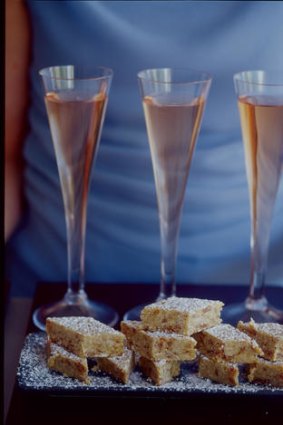This was published 12 years ago
Tickled pink for summer
Light in alcohol and easy on the wallet, chilled moscato is the ideal drink on a warm day.
By Huon Hooke
Moscato's popularity in Australia is booming. But don't make the mistake of thinking they are all much the same - there's a vast gulf between the best and worst, the cheapest and the dearest. And the gap is widening.
On paper, moscato should be the most popular wine in the world. It's slightly sweet and fizzy, has a pretty pink or pale yellow colour, a very low alcohol content and a heaven-sent aroma of fresh muscat grapes. And normally it's very inexpensive.

Blushing beauty ... Australian moscatos can be too sweet, while Italian versions are more delicate.Credit: Jennifer Soo
No wonder moscato sales are going through the roof. Not just in Australia: the US is having a moscato boom.
It's an ideal summer drink, served very cold, as an aperitif or with a fruit-based dessert, or after dinner as a pick-me-up. With moscato, you can hit the jackpot.
The range of alcohols can be wide: in my recent tastings, they varied between 4.5 per cent and 9 per cent.
The traditional Italian version, from Asti in Piedmont, is usually 5.5 per cent.
This is less than half the alcohol of normal dry white wines, which range from about 11 per cent to 14 per cent alcohol. In other words, you can drink twice as much for the same effect.
Those with long memories will snort and observe that sweet, fizzy muscat-flavoured wine has always been with us, in one guise or another. Today's moscato is just yesteryear's Kaiser Stuhl Summer Wine or Miranda Golden Gate Spumante, or even Lindeman's Sparkling Porphyry Pearl.
It's a sound argument: like vanilla ice-cream, cheap, sweet, muscaty, slightly fizzy wines will probably always be popular. What is curious is how much better most Piedmontese moscatos are than most Australian attempts.
We have dumbed-down moscato, for sure, so most locals are in the $15 to $20 segment but the biggest growth-area is in the $5 to $10 price range. The best Italian versions are the likes of Vietti Cascinetta, La Spinetta Bricco Quaglia and Piero Gatti. They're between $30 and $40 a bottle in Sydney shops. But they are also far superior to most of ours.
Take Vietti, which I've always thought the Rolls-Royce (or should that be Ferrari?) of moscato.
This has a dreamy scent, which is muscaty, yes, but also a lot more: flowery and spicy and full of mysterious detail, and in the mouth it has a marvellously persistent effervescence, which balances a carefully determined sweetness and delicate, grapy fruitiness. The acidity is there, but it's not shrill or assertive, like so many local versions (which are probably acid adjusted, because the grapes are grown in regions that are too hot).
This is a wine I could happily drink several glasses of as it is just so lip-smackingly moreish. And at 5.5 per cent alcohol (lower than many Australians), you can almost drink the whole bottle. Even at $39, the quality justifies the outlay.
The main reason for moscato d'Asti's superiority is the grape.
They use moscato bianco, which the French call muscat blanc a petits grains, the small-berry muscat, which is the highest quality but has a lower yield.
Here, we use frontignac or even muscat gordo blanco, which is far less fine, especially when grown in hot irrigation areas, as it often is.
Interestingly, the best local version I've tasted recently, the Chalmers family's Montevecchio (grown on the family estate at Heathcote, central Victoria) is made from moscato giallo.
There are many muscat grapes: Jancis Robinson's Guide to Wine Grapes says giallo is a mutation of moscato bianco with deeper-coloured berries.
I also find many Australian moscatos too sweet, too alcoholic and lacking effervescence.
In the best Astis, the gas is an important component of the wines' balance. Aztec data (based on Woolworths liquor sales) shows the dumbing-down of moscato continues apace. In dollar terms, it's growing at 20.5 per cent a year; in volume at 32.7 per cent
In other words, the gap between the best and the worst moscato in quality and price is growing fast and will continue to do so.
The other quality factor is where the grapes are grown. It's no accident that Italy's best moscato comes from the cooler north. All grape varieties produce their finest wine in regions where they're at their climatic limit. Hence, pinot noir in the Cote d'Or, sauvignon blanc in Sancerre, grenache in the southern Rhone and shiraz in the northern Rhone.
Our Murray Valley and Riverina may be good for large tonnages of irrigated muscat gordo blanco, enabling wine to be sold at $5 a bottle, but that is definitely the Hyundai Excel compared to the Maserati GranCabrio.
As always, you pay your money and you make your choice.
Huon's pick of moscatos
ITALIAN
(all 5.5 per cent alcohol)
Vietti Cascinetta $39
La Spinetta $39
Piero Gatti $30
Handpicked $25
Giacomo Bologna ''Braida'' Brachetto d'Acqui $25/375ml
AUSTRALIAN
Montevecchio, Heathcote, 5.5 per cent, $21
Two Hands Brilliant Disguise, Barossa, 8 per cent, $18/500ml
Innocent Bystander, Victoria, 5.5 per cent, $12/375ml
BEST OF THE CHEAPIES
Buller Beverford, Victoria, 6 per cent, $13
Zonin Asti Dolce, Italy, 7.5 per cent, $11
NOTE: Always choose the most recent vintage.